child restraint VOLKSWAGEN POLO 2015 Owner´s Manual
[x] Cancel search | Manufacturer: VOLKSWAGEN, Model Year: 2015, Model line: POLO, Model: VOLKSWAGEN POLO 2015Pages: 100, PDF Size: 4.14 MB
Page 37 of 100
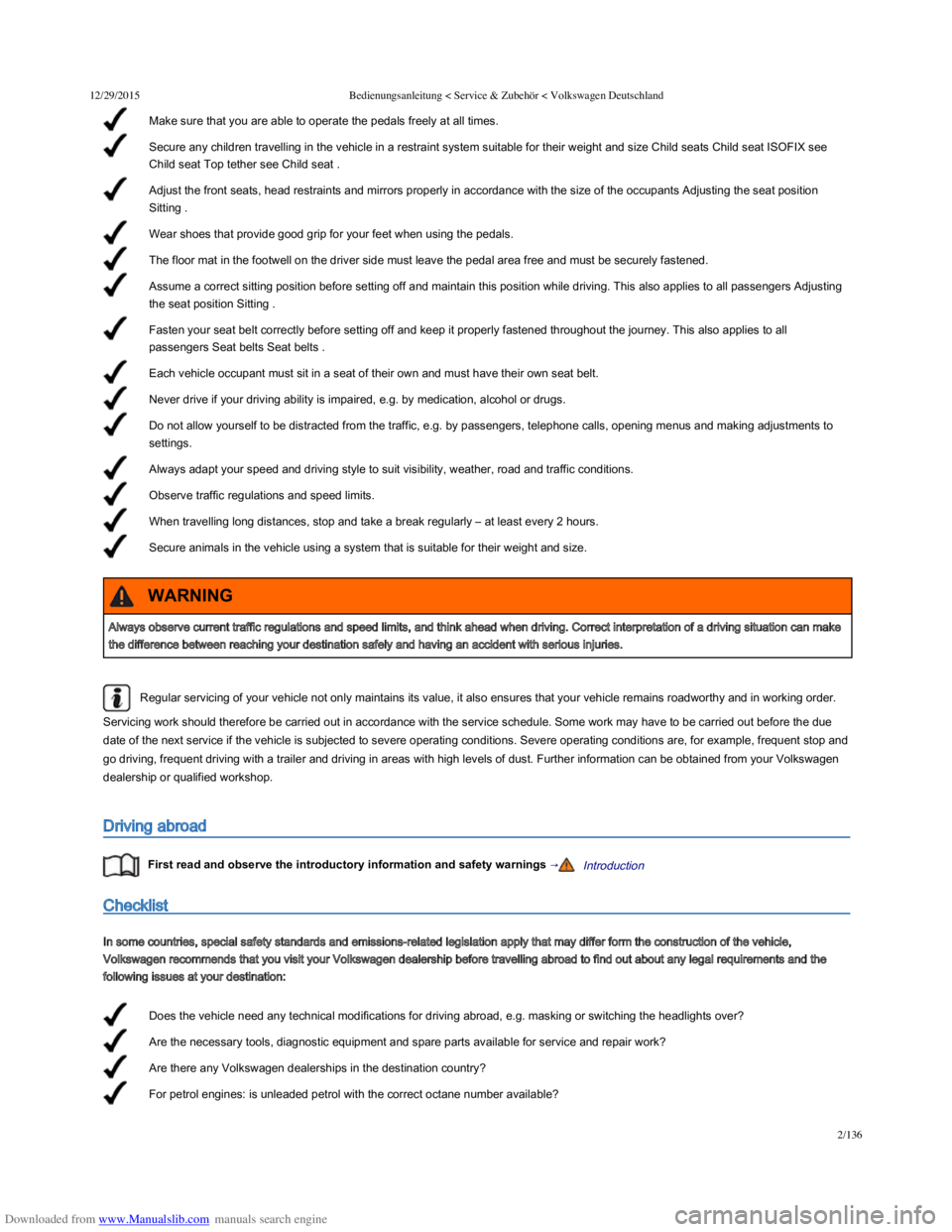
Downloaded from www.Manualslib.com manuals search engine 12/29/2015Bedienungsanleitung < Service & Zubehör < Volkswagen Deutschland
2/136
Make sure that you are able to operate the pedals freely at all times.
Secure any children travelling in the vehicle in a restraint system suitable for their weight and size Child seats Child seat ISOFIX see
Child seat Top tether see Child seat .
Adjust the front seats, head restraints and mirrors properly in accordance with the size of the occupants Adjusting the seat position
Sitting .
Wear shoes that provide good grip for your feet when using the pedals.
The floor mat in the footwell on the driver side must leave the pedal area free and must be securely fastened.
Assume a correct sitting position before setting off and maintain this position while driving. This also applies to all passengers Adjusting
the seat position Sitting .
Fasten your seat belt correctly before setting off and keep it properly fastened throughout the journey. This also applies to all
passengers Seat belts Seat belts .
Each vehicle occupant must sit in a seat of their own and must have their own seat belt.
Never drive if your driving ability is impaired, e.g. by medication, alcohol or drugs.
Do not allow yourself to be distracted from the traffic, e.g. by passengers, telephone calls, opening menus and making adjustments to
settings.
Always adapt your speed and driving style to suit visibility, weather, road and traffic conditions.
Observe traffic regulations and speed limits.
When travelling long distances, stop and take a break regularly – at least every 2 hours.
Secure animals in the vehicle using a system that is suitable for their weight and size.
Does the vehicle need any technical modifications for driving abroad, e.g. masking or switching the headlights over?
Are the necessary tools, diagnostic equipment and spare parts available for service and repair work?
Are there any Volkswagen dealerships in the destination country?
For petrol engines: is unleaded petrol with the correct octane number available?
Regular servicing of your vehicle not only maintains its value, it also ensures that your vehicle remains roadworthy and in working order.
Servicing work should therefore be carried out in accordance with the service schedule. Some work may have to be carried out before the due
date of the next service if the vehicle is subjected to severe operating conditions. Severe operating conditions are, for example, frequent stop and
go driving, frequent driving with a trailer and driving in areas with high levels of dust. Further information can be obtained from your Volkswagen
dealership or qualified workshop.
Driving abroad
First read and observe the introductory information and safety warnings →Introduction
Checklist
In some countries, special safety standards and emissions-related legislation apply that may differ form the construction of the vehicle,
Volkswagen recommends that you visit your Volkswagen dealership before travelling abroad to find out about any legal requirements and the
following issues at your destination:
Always observe current traffic regulations and speed limits, and think ahead when driving. Correct interpretation of a driving situation can make
the difference between reaching your destination safely and having an accident with serious injuries.
WARNING
Page 68 of 100
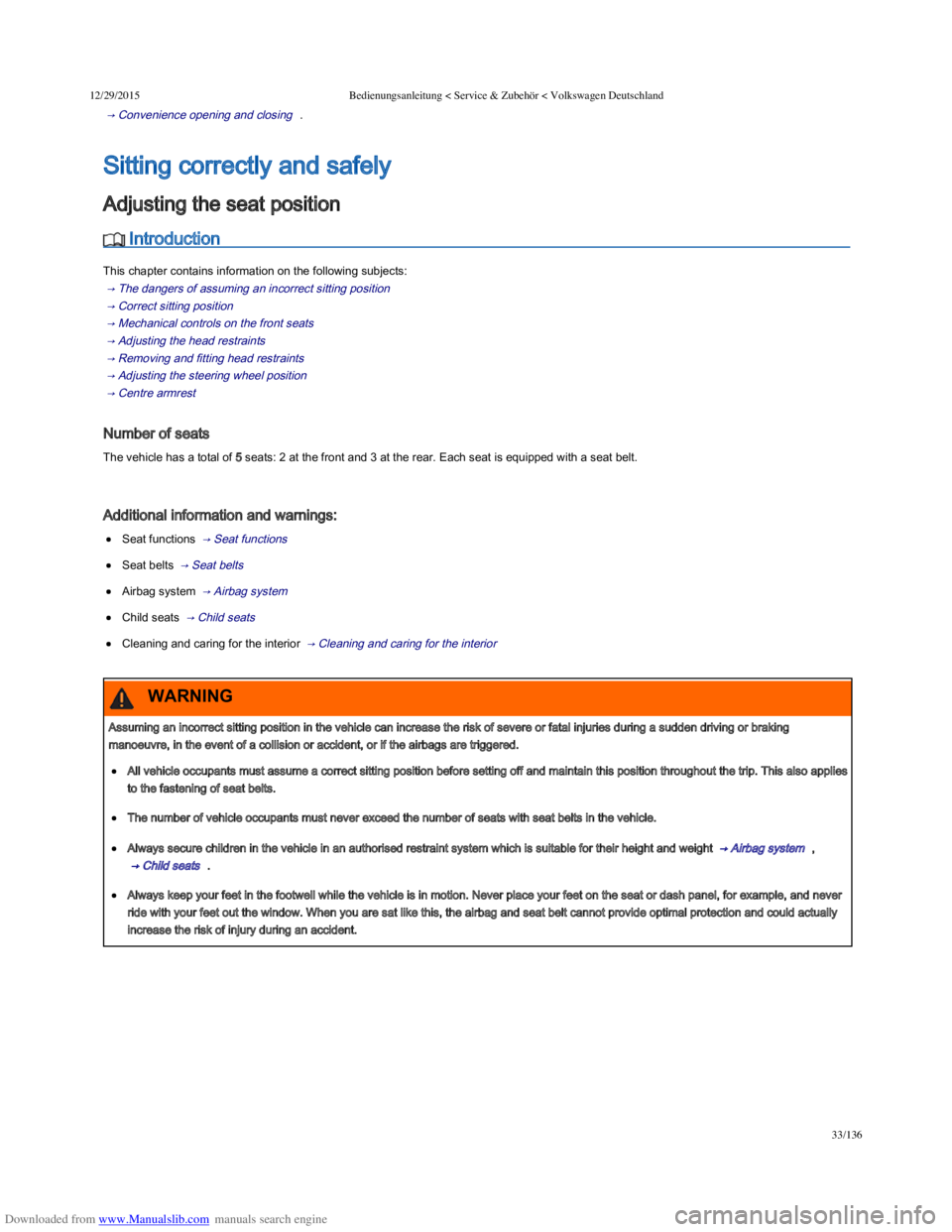
Downloaded from www.Manualslib.com manuals search engine 12/29/2015Bedienungsanleitung < Service & Zubehör < Volkswagen Deutschland
33/136
→ Convenience opening and closing .
Introduction
This chapter contains information on the following subjects:
→ The dangers of assuming an incorrect sitting position
→ Correct sitting position
→ Mechanical controls on the front seats
→ Adjusting the head restraints
→ Removing and fitting head restraints
→ Adjusting the steering wheel position
→ Centre armrest
Number of seats
The vehicle has a total of 5 seats: 2 at the front and 3 at the rear. Each seat is equipped with a seat belt.
Additional information and warnings:
Seat functions → Seat functions
Seat belts → Seat belts
Airbag system → Airbag system
Child seats → Child seats
Cleaning and caring for the interior → Cleaning and caring for the interior
Sitting correctly and safely
Adjusting the seat position
Assuming an incorrect sitting position in the vehicle can increase the risk of severe or fatal injuries during a sudden driving or braking
manoeuvre, in the event of a collision or accident, or if the airbags are triggered.
All vehicle occupants must assume a correct sitting position before setting off and maintain this position throughout the trip. This also applies
to the fastening of seat belts.
The number of vehicle occupants must never exceed the number of seats with seat belts in the vehicle.
Always secure children in the vehicle in an authorised restraint system which is suitable for their height and weight → Airbag system ,
→ Child seats .
Always keep your feet in the footwell while the vehicle is in motion. Never place your feet on the seat or dash panel, for example, and never
ride with your feet out the window. When you are sat like this, the airbag and seat belt cannot provide optimal protection and could actually
increase the risk of injury during an accident.
WARNING
Page 69 of 100
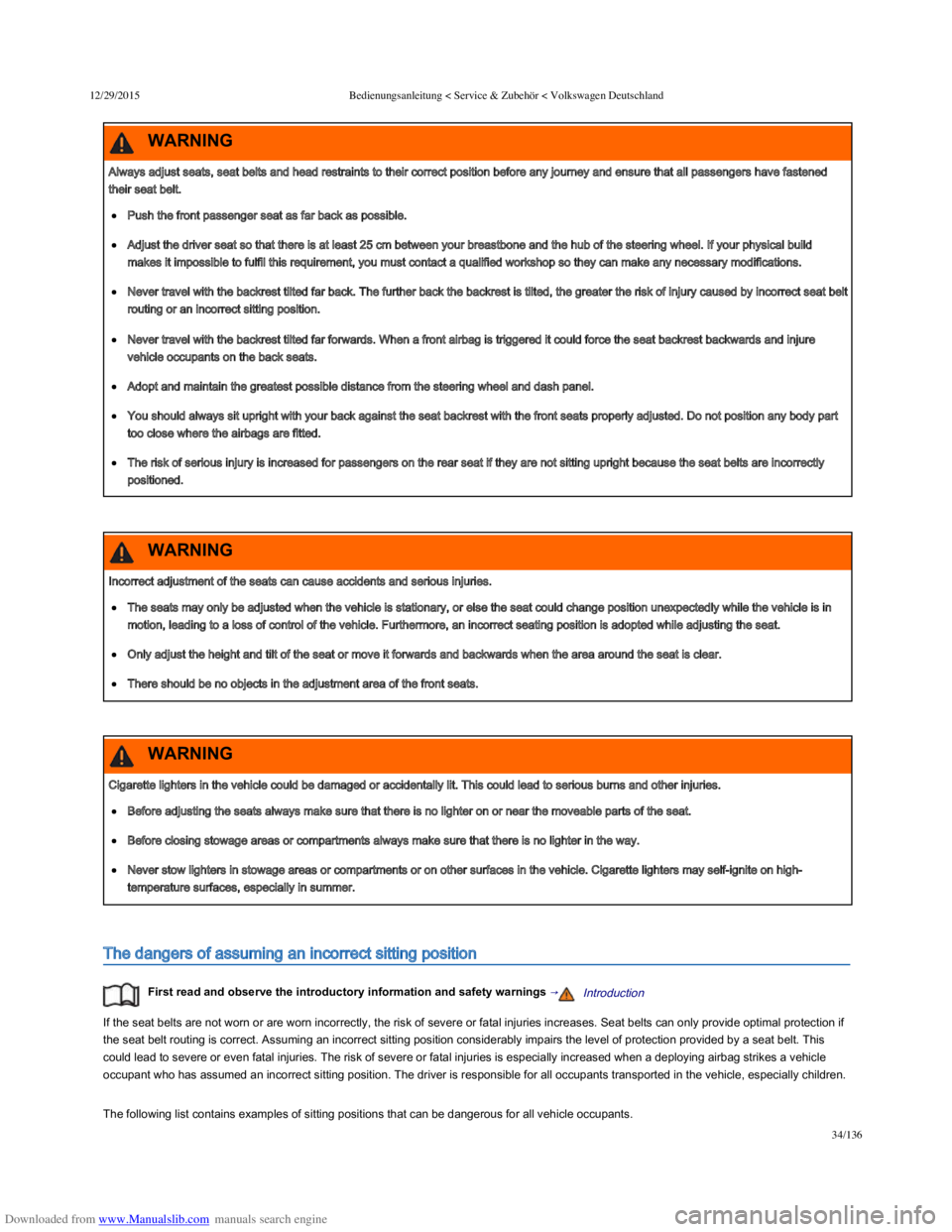
Downloaded from www.Manualslib.com manuals search engine 12/29/2015Bedienungsanleitung < Service & Zubehör < Volkswagen Deutschland
34/136
The dangers of assuming an incorrect sitting position
First read and observe the introductory information and safety warnings →Introduction
If the seat belts are not worn or are worn incorrectly, the risk of severe or fatal injuries increases. Seat belts can only provide optimal protection if
the seat belt routing is correct. Assuming an incorrect sitting position considerably impairs the level of protection provided by a seat belt. This
could lead to severe or even fatal injuries. The risk of severe or fatal injuries is especially increased when a deploying airbag strikes a vehicle
occupant who has assumed an incorrect sitting position. The driver is responsible for all occupants transported in the vehicle, especially children.
The following list contains examples of sitting positions that can be dangerous for all vehicle occupants.
Always adjust seats, seat belts and head restraints to their correct position before any journey and ensure that all passengers have fastened
their seat belt.
Push the front passenger seat as far back as possible.
Adjust the driver seat so that there is at least 25 cm between your breastbone and the hub of the steering wheel. If your physical build
makes it impossible to fulfil this requirement, you must contact a qualified workshop so they can make any necessary modifications.
Never travel with the backrest tilted far back. The further back the backrest is tilted, the greater the risk of injury caused by incorrect seat belt
routing or an incorrect sitting position.
Never travel with the backrest tilted far forwards. When a front airbag is triggered it could force the seat backrest backwards and injure
vehicle occupants on the back seats.
Adopt and maintain the greatest possible distance from the steering wheel and dash panel.
You should always sit upright with your back against the seat backrest with the front seats properly adjusted. Do not position any body part
too close where the airbags are fitted.
The risk of serious injury is increased for passengers on the rear seat if they are not sitting upright because the seat belts are incorrectly
positioned.
WARNING
Incorrect adjustment of the seats can cause accidents and serious injuries.
The seats may only be adjusted when the vehicle is stationary, or else the seat could change position unexpectedly while the vehicle is in
motion, leading to a loss of control of the vehicle. Furthermore, an incorrect seating position is adopted while adjusting the seat.
Only adjust the height and tilt of the seat or move it forwards and backwards when the area around the seat is clear.
There should be no objects in the adjustment area of the front seats.
WARNING
Cigarette lighters in the vehicle could be damaged or accidentally lit. This could lead to serious burns and other injuries.
Before adjusting the seats always make sure that there is no lighter on or near the moveable parts of the seat.
Before closing stowage areas or compartments always make sure that there is no lighter in the way.
Never stow lighters in stowage areas or compartments or on other surfaces in the vehicle. Cigarette lighters may self-ignite on high-
temperature surfaces, especially in summer.
WARNING
Page 73 of 100
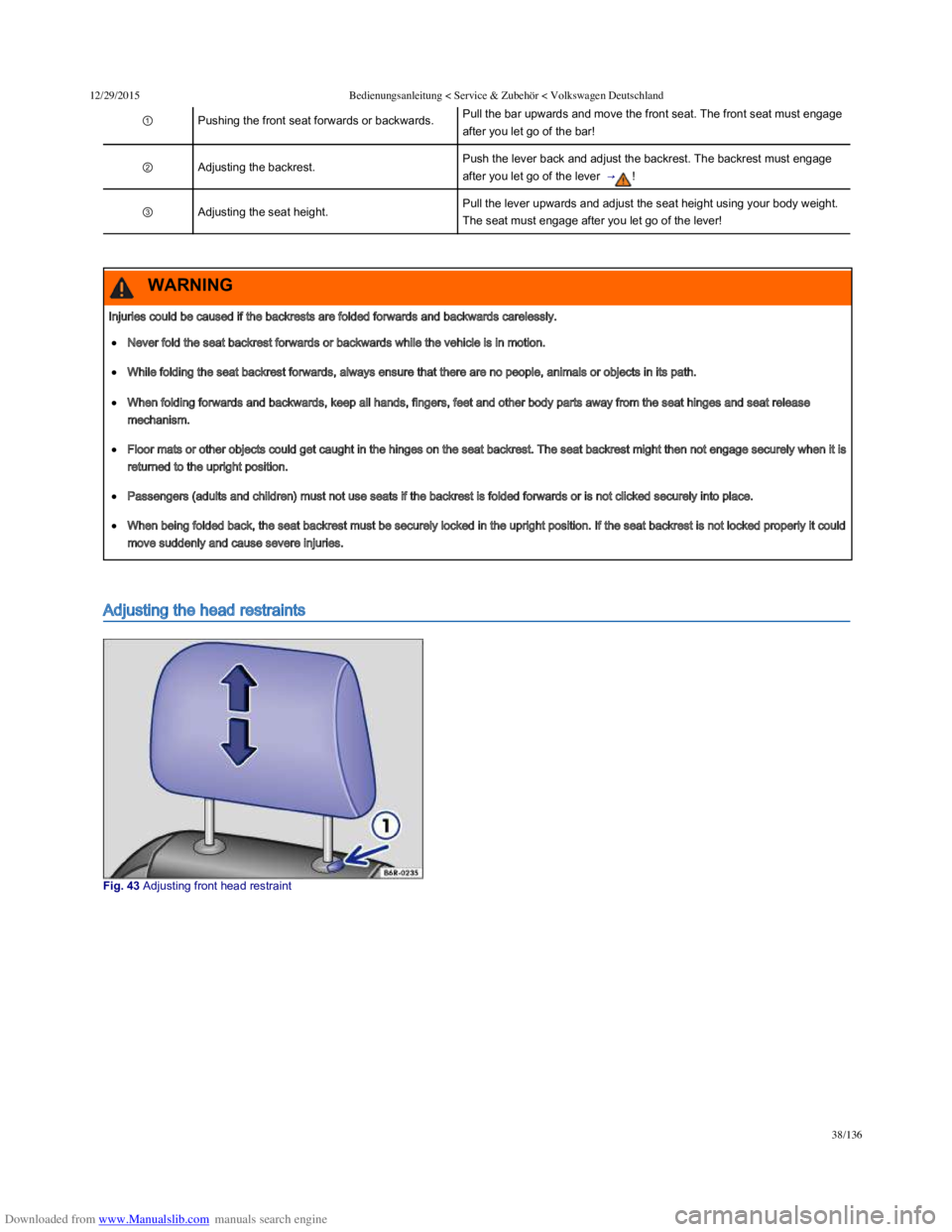
Downloaded from www.Manualslib.com manuals search engine 12/29/2015Bedienungsanleitung < Service & Zubehör < Volkswagen Deutschland
38/136
①Pushing the front seat forwards or backwards.Pull the bar upwards and move the front seat. The front seat must engage
after you let go of the bar!
②Adjusting the backrest.Push the lever back and adjust the backrest. The backrest must engage
after you let go of the lever → !
③Adjusting the seat height.Pull the lever upwards and adjust the seat height using your body weight.
The seat must engage after you let go of the lever!
Adjusting the head restraints
Fig. 43 Adjusting front head restraint
Injuries could be caused if the backrests are folded forwards and backwards carelessly.
Never fold the seat backrest forwards or backwards while the vehicle is in motion.
While folding the seat backrest forwards, always ensure that there are no people, animals or objects in its path.
When folding forwards and backwards, keep all hands, fingers, feet and other body parts away from the seat hinges and seat release
mechanism.
Floor mats or other objects could get caught in the hinges on the seat backrest. The seat backrest might then not engage securely when it is
returned to the upright position.
Passengers (adults and children) must not use seats if the backrest is folded forwards or is not clicked securely into place.
When being folded back, the seat backrest must be securely locked in the upright position. If the seat backrest is not locked properly it could
move suddenly and cause severe injuries.
WARNING
Page 80 of 100
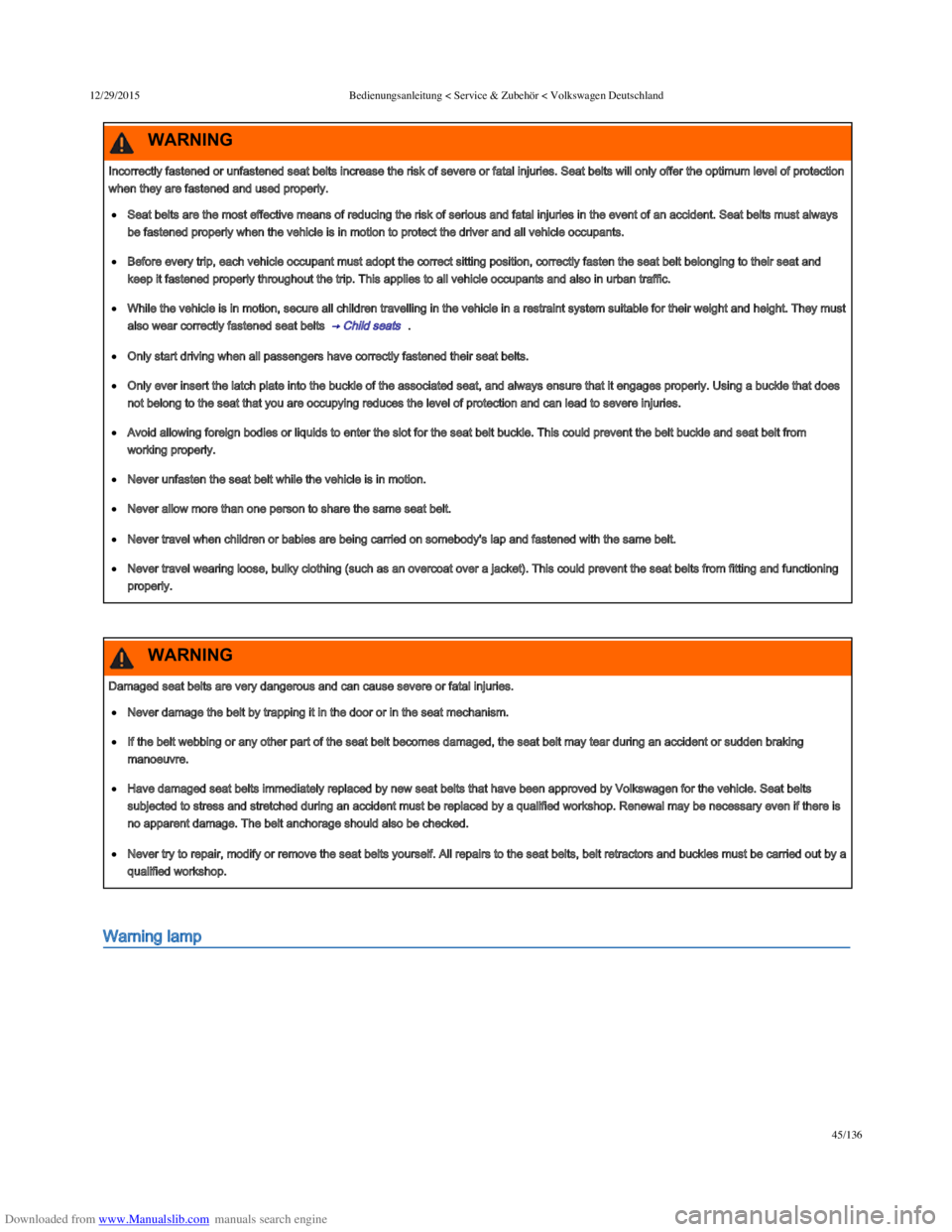
Downloaded from www.Manualslib.com manuals search engine 12/29/2015Bedienungsanleitung < Service & Zubehör < Volkswagen Deutschland
45/136
Warning lamp
Incorrectly fastened or unfastened seat belts increase the risk of severe or fatal injuries. Seat belts will only offer the optimum level of protection
when they are fastened and used properly.
Seat belts are the most effective means of reducing the risk of serious and fatal injuries in the event of an accident. Seat belts must always
be fastened properly when the vehicle is in motion to protect the driver and all vehicle occupants.
Before every trip, each vehicle occupant must adopt the correct sitting position, correctly fasten the seat belt belonging to their seat and
keep it fastened properly throughout the trip. This applies to all vehicle occupants and also in urban traffic.
While the vehicle is in motion, secure all children travelling in the vehicle in a restraint system suitable for their weight and height. They must
also wear correctly fastened seat belts → Child seats .
Only start driving when all passengers have correctly fastened their seat belts.
Only ever insert the latch plate into the buckle of the associated seat, and always ensure that it engages properly. Using a buckle that does
not belong to the seat that you are occupying reduces the level of protection and can lead to severe injuries.
Avoid allowing foreign bodies or liquids to enter the slot for the seat belt buckle. This could prevent the belt buckle and seat belt from
working properly.
Never unfasten the seat belt while the vehicle is in motion.
Never allow more than one person to share the same seat belt.
Never travel when children or babies are being carried on somebody's lap and fastened with the same belt.
Never travel wearing loose, bulky clothing (such as an overcoat over a jacket). This could prevent the seat belts from fitting and functioning
properly.
WARNING
Damaged seat belts are very dangerous and can cause severe or fatal injuries.
Never damage the belt by trapping it in the door or in the seat mechanism.
If the belt webbing or any other part of the seat belt becomes damaged, the seat belt may tear during an accident or sudden braking
manoeuvre.
Have damaged seat belts immediately replaced by new seat belts that have been approved by Volkswagen for the vehicle. Seat belts
subjected to stress and stretched during an accident must be replaced by a qualified workshop. Renewal may be necessary even if there is
no apparent damage. The belt anchorage should also be checked.
Never try to repair, modify or remove the seat belts yourself. All repairs to the seat belts, belt retractors and buckles must be carried out by a
qualified workshop.
WARNING
Page 93 of 100
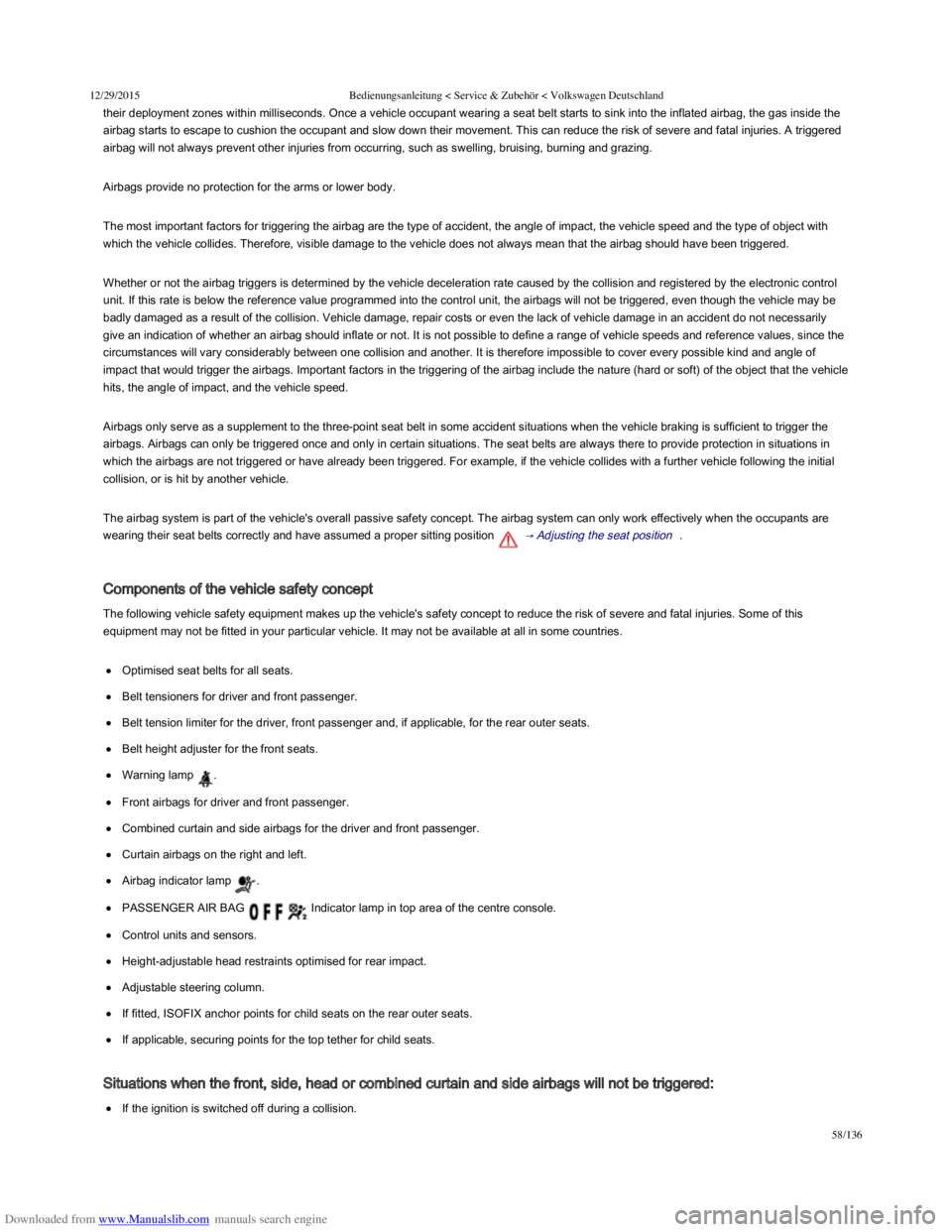
Downloaded from www.Manualslib.com manuals search engine 12/29/2015Bedienungsanleitung < Service & Zubehör < Volkswagen Deutschland
58/136
their deployment zones within milliseconds. Once a vehicle occupant wearing a seat belt starts to sink into the inflated airbag, the gas inside the
airbag starts to escape to cushion the occupant and slow down their movement. This can reduce the risk of severe and fatal injuries. A triggered
airbag will not always prevent other injuries from occurring, such as swelling, bruising, burning and grazing.
Airbags provide no protection for the arms or lower body.
The most important factors for triggering the airbag are the type of accident, the angle of impact, the vehicle speed and the type of object with
which the vehicle collides. Therefore, visible damage to the vehicle does not always mean that the airbag should have been triggered.
Whether or not the airbag triggers is determined by the vehicle deceleration rate caused by the collision and registered by the electronic control
unit. If this rate is below the reference value programmed into the control unit, the airbags will not be triggered, even though the vehicle may be
badly damaged as a result of the collision. Vehicle damage, repair costs or even the lack of vehicle damage in an accident do not necessarily
give an indication of whether an airbag should inflate or not. It is not possible to define a range of vehicle speeds and reference values, since the
circumstances will vary considerably between one collision and another. It is therefore impossible to cover every possible kind and angle of
impact that would trigger the airbags. Important factors in the triggering of the airbag include the nature (hard or soft) of the object that the vehicle
hits, the angle of impact, and the vehicle speed.
Airbags only serve as a supplement to the three-point seat belt in some accident situations when the vehicle braking is sufficient to trigger the
airbags. Airbags can only be triggered once and only in certain situations. The seat belts are always there to provide protection in situations in
which the airbags are not triggered or have already been triggered. For example, if the vehicle collides with a further vehicle following the initial
collision, or is hit by another vehicle.
The airbag system is part of the vehicle's overall passive safety concept. The airbag system can only work effectively when the occupants are
wearing their seat belts correctly and have assumed a proper sitting position → Adjusting the seat position .
Components of the vehicle safety concept
The following vehicle safety equipment makes up the vehicle's safety concept to reduce the risk of severe and fatal injuries. Some of this
equipment may not be fitted in your particular vehicle. It may not be available at all in some countries.
Optimised seat belts for all seats.
Belt tensioners for driver and front passenger.
Belt tension limiter for the driver, front passenger and, if applicable, for the rear outer seats.
Belt height adjuster for the front seats.
Warning lamp .
Front airbags for driver and front passenger.
Combined curtain and side airbags for the driver and front passenger.
Curtain airbags on the right and left.
Airbag indicator lamp .
PASSENGER AIR BAG Indicator lamp in top area of the centre console.
Control units and sensors.
Height-adjustable head restraints optimised for rear impact.
Adjustable steering column.
If fitted, ISOFIX anchor points for child seats on the rear outer seats.
If applicable, securing points for the top tether for child seats.
Situations when the front, side, head or combined curtain and side airbags will not be triggered:
If the ignition is switched off during a collision.
Page 96 of 100

Downloaded from www.Manualslib.com manuals search engine 12/29/2015Bedienungsanleitung < Service & Zubehör < Volkswagen Deutschland
61/136
Fold the key bit of the vehicle key all the way out → Vehicle key set .
Insert the open key bit into the key switch in the stowage compartment → Fig. 62 to the second point of resistance. Around three quarters of
the key bit should be inserted in the key switch at this point → .
Turn the vehicle key, without applying force, to the position.
Remove the vehicle key from the key switch → and fold the key bit away.
Close the stowage compartment on the front passenger side.
When the ignition is switched on, the indicator lamp PASSENGER AIRBAG will light up steadily in the upper section of the centre
console → Indicator lamps .
Enabling the front passenger front airbag
Switch off the ignition.
Open the stowage compartment on the front passenger side.
Fold the key bit of the vehicle key all the way out → Vehicle key set .
Insert the open key bit into the key switch in the stowage compartment → Fig. 62 to the second point of resistance. Around three quarters of
the key bit should be inserted in the key switch at this point → .
Turn the vehicle key, without applying force, to the position.
Remove the vehicle key from the key switch → and fold the key bit away.
Close the stowage compartment on the front passenger side.
Check that the PASSENGER AIRBAG indicator lamp in the upper section of the centre console does not light up when the
ignition is switched on → Indicator lamps .
Ensuring that the front passenger front airbag has been deactivated
The only sure sign that the front passenger front airbag has been deactivated is when the PASSENGER AIRBAG indicator lamp is
displayed in the upper section of the centre console ( lights up yellow steadily) → Indicator lamps .
If the indicator lamp PASSENGER AIR BAG in the upper section of the centre console is not lit up steadily, or if it lights up at the
same time as indicator lamp in the instrument cluster, do not attach any child restraint system to the front passenger seat for safety reasons.
The front passenger front airbag may trigger during an accident.
Do not leave the vehicle key in the key switch while driving.
Strong vibration may cause the vehicle key to turn in the key switch, which could cause the front passenger front airbag to be activated.
Untimely inflation of the front passenger front airbag could lead to serious or fatal injuries.
WARNING